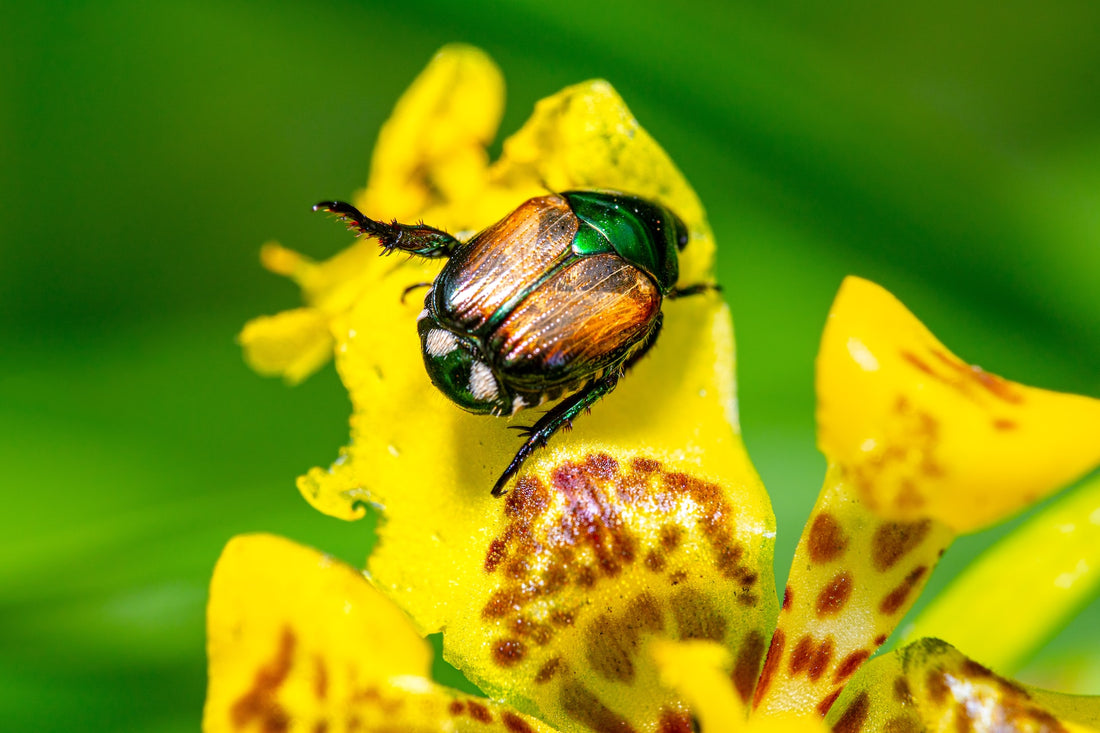Identifying Japanese Beetles
To effectively manage Japanese beetles, it's essential to be able to identify them. Adult beetles are about half an inch long with a shiny, metallic green body and copper-colored wings. They also have six small tufts of white hair along each side of their abdomen. In contrast, the larvae, known as grubs, are C-shaped and have a white body with a brown head. They can be found just below the soil surface, feeding on the roots of grass and other plants.Damage Caused by Japanese Beetles
Japanese beetles are not picky eaters and will feed on a wide variety of plants. They are known to target roses, fruit trees, vegetables, and ornamental plants. They skeletonize leaves by eating the tissue between the veins, leaving behind a lacy appearance. If left unchecked, Japanese beetles can completely defoliate plants, weakening them and making them more susceptible to diseases and other pests.Natural Control Methods for Managing Japanese Beetles
While there are chemical insecticides available for Japanese beetle control, many gardeners (including us!) prefer to use natural and organic methods. These methods not only help protect the environment but also minimize the risk of harming beneficial insects and other wildlife. It's not good for your garden if you kill all the good insects while eliminating the bad; in fact, it leaves more opportunities for the bad ones to come back stronger.
Preventive Measures Against Japanese Beetle Infestations
Prevention is key when it comes to managing Japanese beetles. By implementing cultural control practices, you can reduce the likelihood of an infestation. One effective method is to regularly inspect your plants for signs of Japanese beetles and manually remove them. This can be done by handpicking the beetles and dropping them into a bucket of soapy water.
Another preventive measure is to remove any overripe or damaged fruits that may attract beetles. Japanese beetles are particularly drawn to ripe fruits like peaches and raspberries. By promptly removing these attractants, you can minimize the risk of an infestation.
Attracting Beneficial Insects to Combat Japanese Beetles
One of the best ways to control Japanese beetles naturally is by attracting beneficial insects to your garden. Beneficial insects, such as ladybugs, lacewings, and parasitic wasps, feed on the eggs and larvae of Japanese beetles, helping to keep their populations in check. You can attract these beneficial insects by planting a diverse range of flowering plants, providing them with nectar and pollen as food sources.
Creating a habitat that supports beneficial insects involves planting a variety of flowers with different bloom times to provide a continuous food supply. Additionally, avoiding the use of broad-spectrum insecticides will ensure that the beneficial insects are not harmed.
Using Organic Insecticides for Japanese Beetle Control
If natural control methods alone are not sufficient to manage the Japanese beetle population in your garden, you can consider using organic insecticides as a last resort. Organic insecticides derived from natural substances like pyrethrins or neem oil can be effective against Japanese beetles without causing harm to the environment or beneficial insects, if done correctly.
When using organic insecticides, it's important to read and follow the instructions carefully. Apply the insecticide during the early morning or late evening when the beetles are most active. Be sure to target the undersides of leaves where the beetles tend to feed and apply the product according to the recommended dosage. Cover the plants immediately afterward with row covers to prevent beneficial insects from being harmed.
Planting Japanese Beetle-Resistant Plants
Another natural approach to managing Japanese beetles is to choose plants that are less attractive to them. While no plant is completely immune to Japanese beetle feeding, some plants are more resistant than others. By incorporating these resistant plants into your garden, you can reduce the likelihood of severe damage caused by Japanese beetles.
Some examples of Japanese beetle-resistant plants include yarrow, catmint, lavender, and coneflowers. These plants have either a strong scent, fuzzy leaves, or tough foliage, which makes them less appealing to Japanese beetles. By diversifying your plant selection and incorporating these resistant plants, you can create a less attractive environment for Japanese beetles.
DIY Traps and Deterrents for Japanese Beetles
If you're looking for a hands-on approach to managing Japanese beetles, DIY traps and deterrents can be an effective option. These traps work by attracting the beetles with a lure and then trapping them inside, preventing them from feeding on your plants. However, it's important to note that these traps should be used strategically, as they can also attract more beetles to your garden.
One popular DIY trap involves placing a container filled with soapy water beneath a hanging lure. The beetles are attracted to the lure and fall into the soapy water, where they drown. Another deterrent option is to sprinkle diatomaceous earth around your plants. This powdery substance is made from the fossilized remains of marine organisms and acts as a physical barrier, deterring the beetles from feeding. Diatomaceous earth only really works with the larvae, though, as the adult beetles have a hard shell protecting them from the effects.
Integrated Pest Management for Long-Term Japanese Beetle Control
To achieve long-term control of Japanese beetles, it's important to adopt an integrated pest management (IPM) approach. Some key components of an IPM approach for Japanese beetle control include monitoring beetle populations, identifying the most vulnerable plants, and implementing cultural control practices.
Regularly inspect your plants for signs of beetle activity and take action when necessary. By combining natural control methods, such as handpicking, attracting beneficial insects, and using organic insecticides, you can achieve long-term control of Japanese beetles without relying solely on chemical interventions.



